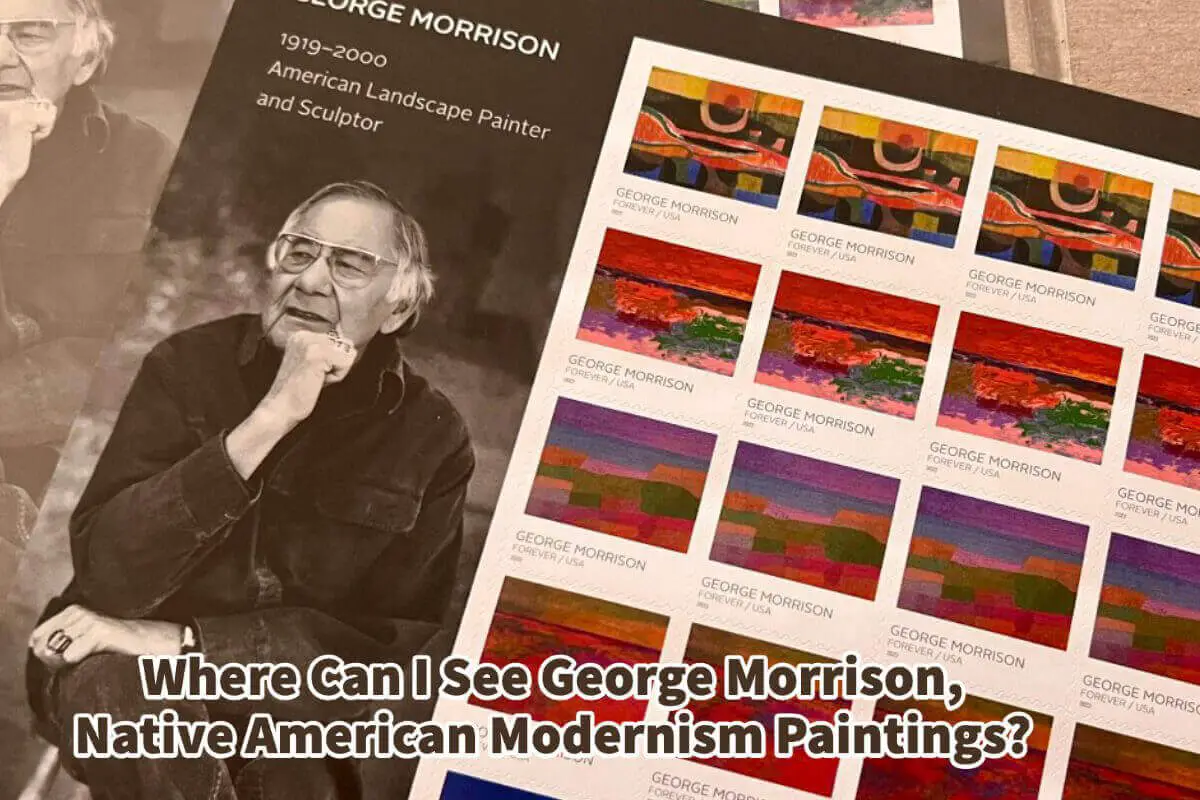George Morrison is considered one of the most important modernist artists, yet few people know his name or story. He is also a founding figure of Native American Modernism.
George Morrison is considered one of the great Native American Artists. He had a unique style of art that brought in Native American thought and motifs in a modern and abstract expressionist way. His works are found at the Minnesota Museum of American Art; some are in collections at the Heard Museum, Minneapolis Institute of Art, Philadelphia Museum of Art, Walker Art Center, and Whitney Museum of American Art.
Table of Contents
- Who Is The Native American Modernist George Morrison (1919 – 2000)?
- George Morrison’s Art Is Honored On A US Postage Stamp
- About Native American Modernism Art
- Frequently Asked Questions
- Related Questions
Raised on the shores of Lake Superior, later in his life, he returned to his roots on the Indian reservation and became a prolific artist. He was horror on a US postage stamp showing five pieces of his art.
Table of Contents
- Who Is The Native American Modernist George Morrison (1919 – 2000)?
- George Morrison’s Art Is Honored On A US Postage Stamp
- About Native American Modernism Art
- Frequently Asked Questions
- Related Questions
Who Is The Native American Modernist George Morrison (1919 – 2000)?
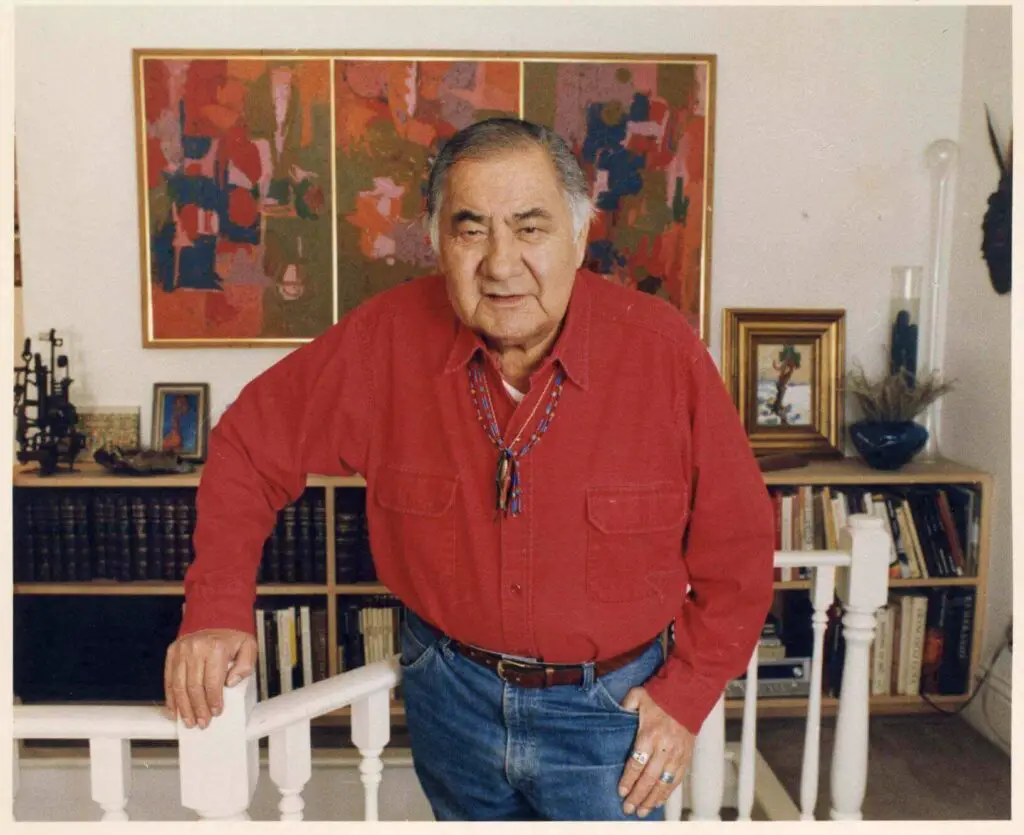
George Morrison (1919-2000) was a celebrated Minnesota artist who, throughout his career, developed a unique vision and style of painting that combined the bold, colorful expressionism of Native American Modernism.
Most of his works of art are found in the Minnesota Museum of American Art. Still, some of his artwork also exists in collections at the Heard Museum, Minneapolis Institute of Art, Philadelphia Museum of Art, Walker Art Center, and Whitney Museum of American Art.
George Morrison – Ojibewe Indian Artist
George Morrison grew up in Chippewa City, Minnesota, a rustic fishing village on the North Shore of Lake Superior. He was an Ojibewe Indian who spoke his native Indian language.
Morrison started creating art after a year-long hip surgery recovery when he was younger; he took up reading, drawing, and carving to help pass the time. He was supported by teachers who encouraged him to continue with his art.
He graduated from Grand Marias High School in 1938, Minneapolis School of Art (now Minneapolis College of Art and Design) in 1943, and New York Art Student’s League in 1946.
He was known to be a friend of Willem de Kooning; both of them participated in art exhibitions in Manhattan and throughout New York City. George Morrison had 12 one-person shows in New York Between 1948 and 1960.
He later became a Fulbright scholar and studied and worked in Paris, France, and Aix-en-Provence in 1952 and 1953. In the 1950s, he was active as a teacher and exhibiting artist in New York, Provincetown, and throughout the United States.
Later he taught at the Rhode Island School of design and the University of Minnesota.
George Morrison And The Found Objects Sculptures And Collages
In the 1960s, while spending a summer at the seashore, George Morrison began making collages with driftwood or found objects that he found along the shore. These sculptures became award-winning sculptures that museums, corporations, and private individuals widely collected.
Earlier in his career, he tried to show similar sculptures, but they were rebuffed because it was said that they were not American Indian art or style. But by the 1960s, the sculptures were accepted and highly sought after.
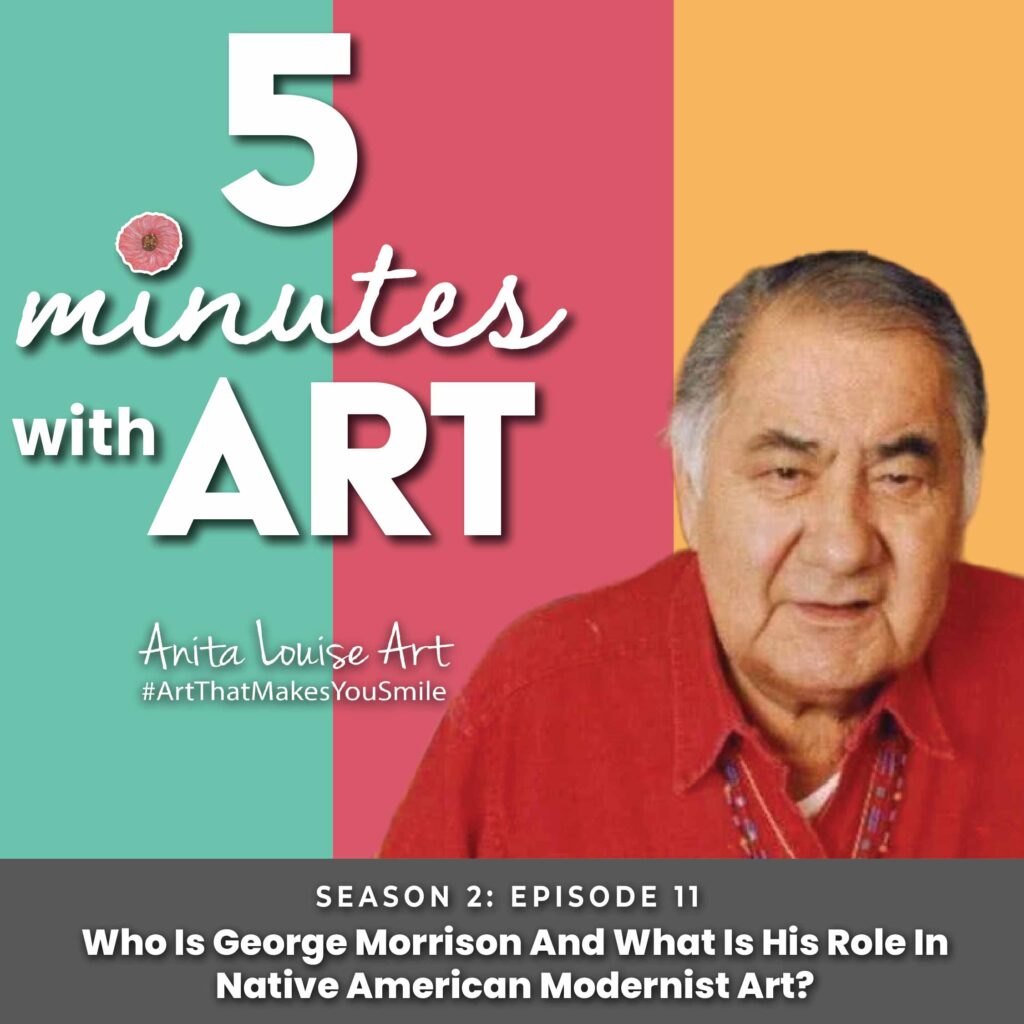
Listen To Our Podcast About Who Is George Morrison And What Is His Role In Native American Modernist Art? by clicking here.
George Morrisons Returns Home To His Roots – Grand Portage Indian Reservation
After he retired from teaching in 1983, George Morrison worked for 17 years from his studios and home on the Grand Portage Indian Reservation along the north shore of Lake Superior. This was near the place where she was raised and born.
From this area, Morrison produced different series of paintings and collages of various scales. His paintings were in response to three things that were important to him – land, water, and sky.
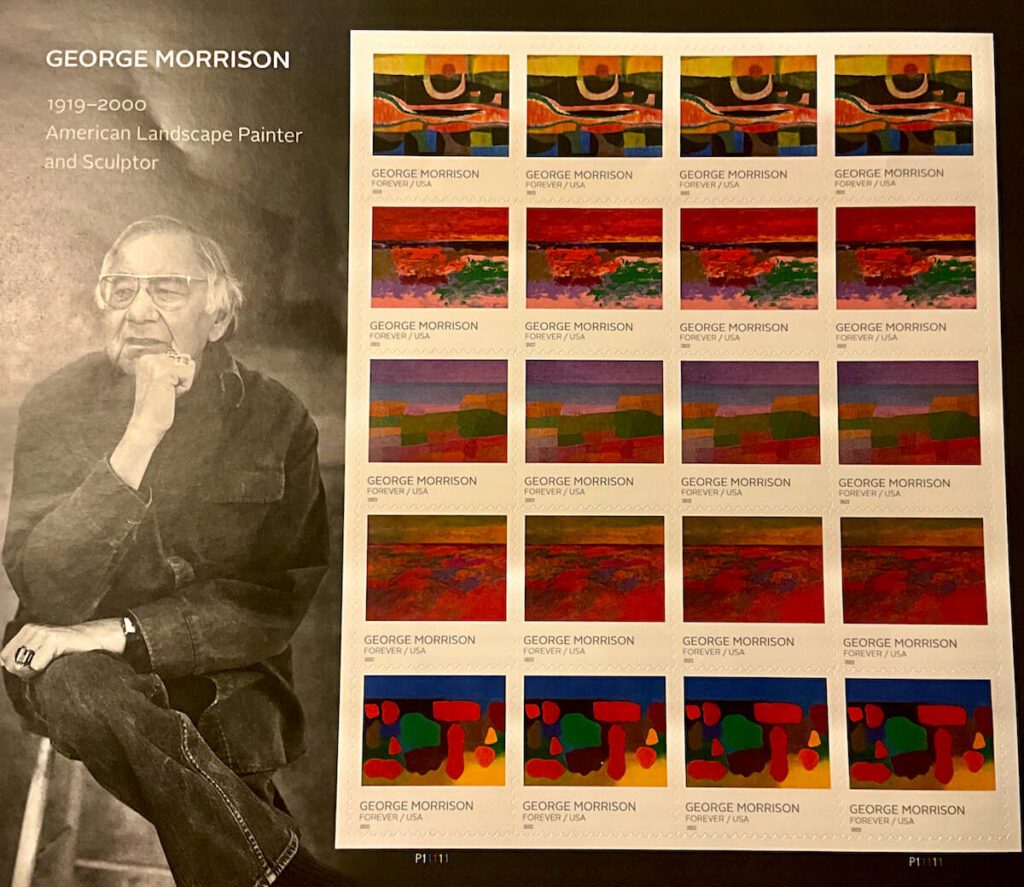
George Morrison’s Art Is Honored On A US Postage Stamp

Many consider it long overdue for such a great artist that has won so many awards to be honored on a US postage stamp. Many of his artwork on the stamps represent the space where water and sky meet, and the horizon line also symbolically marks the boundary between the known and unknown.
The postage stamps show five of his paintings as follows:
Sun And River 1949 By George Morrison
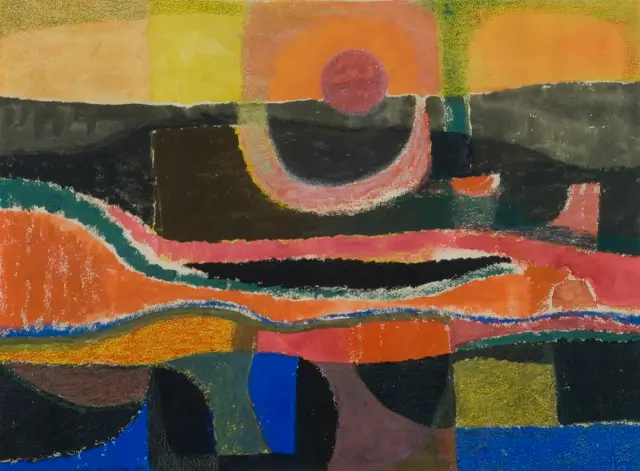
Sun and River 1949 by George Morrison is a watercolor and crayon on paper. The work is now part of the Plains Art Museum.
Phenomena Against The Crimson; Lake Superior Landscape 1985, By George Morrison
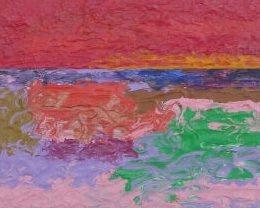
The other painting, called Phenomena Against the Chrism Lake Superior Landscape, is acrylic on canvas. This artwork is part of the Minnesota Museum of American Art collection.
Lake Superior Landscape, 1981, By George Morrison
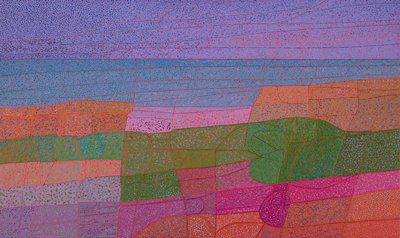
The Lake Superior landscape 1981 is an acrylic on canvas; this work is also part of the Minneapolis Institute of art.
Spirit Path, New Day, Red Rock Variation: Lake Superior Landscape 1990 By George Morrison
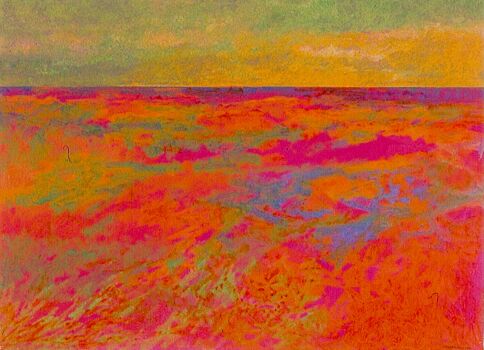
Spirit Path, New Day, Red Rock Variation: Lake Superior Landscape 1990 is acrylic and pastel on paper. This artwork is part of the Minnesota Museum of American Art collection.
Untitled, 1995, By George Morrison
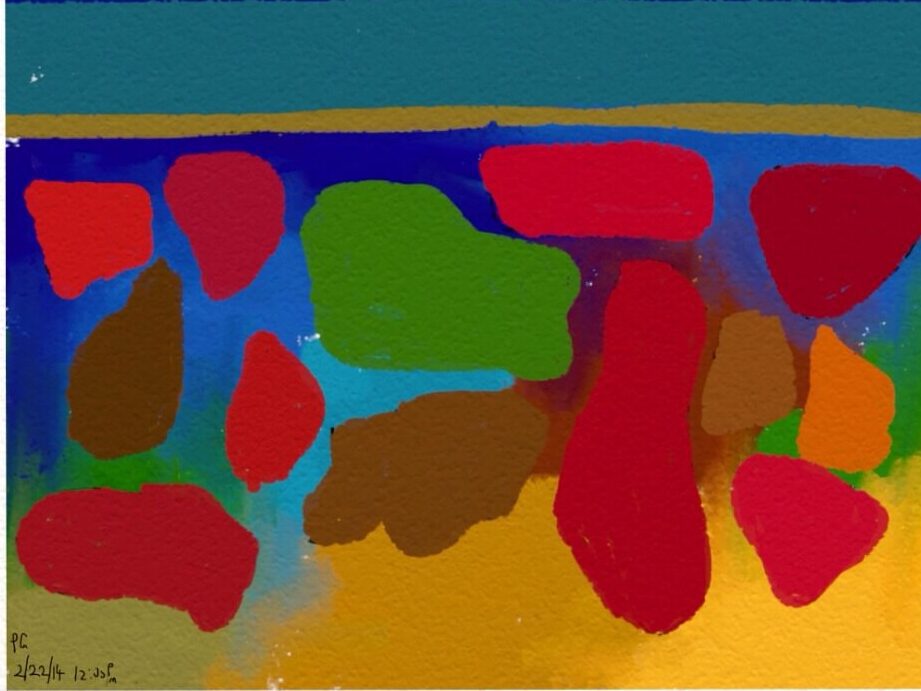
The final artwork featured on the US postage stamp is untitled, 1995, a colored pencil on paper. This work is part of the private collection of Krista and Bill Thornburn.
About Native American Modernism Art
George Morrison and Allan Houser are two prominent US artists who inspired generations of Native American Art. They both rebelled against what Native American art should look like but put in their own original personal style.
Their artwork is called Native American Modernism or Native Modernism.
George Morrison was a painter of vivid colors, and his unique style of Native American art influenced many other artists. He had an individualistic style of abstract expressionism.
Allan Houser was a Chincahua Apache Sculptor, painter, and book illustrator and one of the renowned Native American painters and sculptors. He was able to blend Native American subject matter into modern aesthetics.
This Native American artist kept true to their Native American roots in their art as they emphasized things essential to them, such as stone, water, air, and land. They brought the natural elements and Native American Indian beliefs into their modernist art.
Anita Louise Art is dedicated to art education, great artists, and inspiring others to find and create their art. We love art that uplifts and inspires. #ArtToMakeYouSmile! #ArtToMakeYouHappy!
If you are interested to see any of my art, you can find out more by clicking here. If you are interested in what inspires me and my paintings, you can discover more by clicking here.
We have a free newsletter and would love you to be part of our community; you can subscribe to the newsletter by clicking here. If you have any questions, I would be happy to talk to you at any time. You can reach me, Anita, by clicking here.
Subscribe to our Anita Louise Art YouTube Channel filled with great videos and information by clicking here.
Frequently Asked Questions
Who was George Morrison?
George Morrison was a significant Native American artist known for his abstract expressionist works. Born in 1919 on the Grand Portage Indian Reservation in Minnesota, Morrison became a renowned artist integrating Native American themes with modern art techniques.
What was George Morrison’s style of art?
Morrison’s style was a fusion of Abstract Expressionism and elements derived from his Native American heritage. His work often incorporated natural forms, landscapes, and symbolic motifs rendered in an abstract style.
What are some of George Morrison’s most famous works?
Some of Morrison’s well-known works include the “Wood Collage” series and “Horizon” series, which beautifully combine abstract expressionism with motifs from his Native American background.
How did George Morrison contribute to Native American art?
George Morrison was pivotal in integrating Native American themes with contemporary art. His unique blend of abstract expressionism and Native American motifs helped bring indigenous art forms into the mainstream.
What materials did George Morrison use in his artwork?
Morrison used various materials in his work, including wood, paint, and pencil. He is mainly known for his “Wood Collage” series, in which he created abstract landscapes from found pieces of wood.
Did George Morrison receive any significant awards for his work?
George Morrison received numerous awards throughout his career, including a Guggenheim Fellowship in 1970 and the Lifetime Achievement Award from the Eiteljorg Museum of American Indians and Western Art in 1997.
What role did nature play in George Morrison’s work?
Nature was a significant theme in Morrison’s work, inspired by his upbringing on the shores of Lake Superior. He incorporated natural forms and elements into his abstract compositions, reflecting his deep connection to the natural world.
Why is George Morrison considered an important Native American artist?
George Morrison is regarded as a pivotal figure in Native American art for several reasons. Firstly, he was among the first Native American artists to gain recognition in the broader American contemporary art scene, especially for his abstract work. Secondly, his art bridged the gap between Native American traditions and modern art forms, challenging the stereotypes and expectations of what Native American art should look like. Finally, as an educator, he significantly influenced a generation of artists, both Native and non-Native, expanding the understanding and appreciation of Indigenous art forms.
How did George Morrison’s heritage influence his art?
While Morrison’s work is primarily abstract and does not depict traditional Native American imagery, his heritage influenced his deep connection to the natural world, particularly the landscapes of Lake Superior and the northern Minnesota region. His art often reflects a profound sense of place and belonging intrinsic to his Indigenous roots.
What role did George Morrison play in the Native American art community?
George Morrison played a crucial role in breaking stereotypes about Native American art. He was a pioneer who showed that Native American artists could engage with contemporary art movements and create work that was both modern and deeply connected to their cultural heritage. He also served as a mentor and teacher to many younger Native American artists, helping to foster and develop their talents.
How did George Morrison’s style evolve over his career?
Morrison’s style evolved significantly over his career. He started with more figurative work and gradually moved towards abstraction. Surrealism and Cubism influenced his early work, while his later work incorporated elements of Abstract Expressionism. His most famous wood collages and landscapes from the latter part of his career exhibit a refined, abstract style that synthesizes his artistic influences with his personal vision.
Where can one see George Morrison’s art today?
George Morrison’s art is displayed in various museums and galleries across the United States. Notable collections include the Minnesota Museum of American Art, the National Museum of the American Indian, and the Heard Museum. His works are also part of many private collections and occasionally appear in major art exhibitions.
What was George Morrison’s approach to teaching art?
As an educator, Morrison emphasized the importance of individual artistic expression and encouraged his students to explore various styles and mediums. He believed in the universality of art and its power to transcend cultural boundaries, an approach that resonated with many of his students from diverse backgrounds.
How has George Morrison influenced contemporary Native American artists?
Morrison’s influence on contemporary Native American artists is profound. He opened doors for Native artists in mainstream art circles and demonstrated that Indigenous art could be part of the broader narrative of American art. His fusion of Indigenous perspectives with modernist techniques has inspired many contemporary Native American artists to explore similar paths, pushing the boundaries of how Native art is perceived and understood.
Related Questions
Why Do People Say, ”Life Is Like Drawing Without An Eraser?
Many times, artists, myself included, will use an eraser to remove any marks or measurements we may have made on a paper to measure out and organize their drawings or artwork on their canvas or paper. For most artists having a good eraser is essential.
By clicking here, you can learn more by reading Why Do People Say, ”Life Is Like Drawing Without An Eraser?.
Is Communism Good For The Arts?
Communism is not suitable for art and for many artists under Communism the art should have a purpose and way to help further the communist ideals and ideology. In a Communist society, many artists are labeled as dissidents; others are forced to use their talents to create propaganda art.
By clicking here, you can learn more by reading Is Communism Good For The Arts?.
12 Years Leonardo Painted Mona Lisa’s Lips, Facts Or Fiction?
There is no evidence to show that Leonardo da Vinci spent 12 years painting the Mona Lisa smile. Most scholars believe that he painted the painting in 4 years but then had the painting much longer in his possession. He could have worked on it a bit or adjusted it when he had it in his possession, but there is no evidence to show that.
By clicking here, you can learn more by reading 12 Years Leonardo Painted Mona Lisa’s Lips, Facts Or Fiction?.

